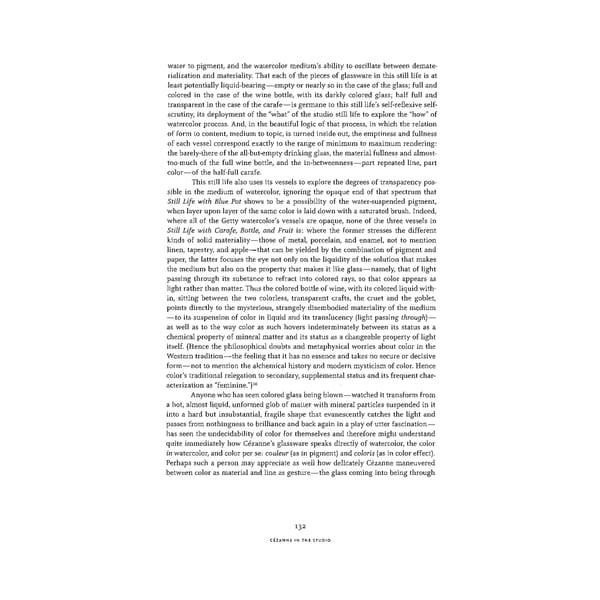water to pigment, and the watercolor medium's ability to oscillate between demate- rialization and materiality. That each of the pieces of glassware in this still life is at least potentially liquid-bearing—empty or nearly so in the case of the glass; full and colored in the case of the wine bottle, with its darkly colored glass; half full and transparent in the case of the carafe—is germane to this still life's self-reflexive self- scrutiny, its deployment of the "what" of the studio still life to explore the "how" of watercolor process. And, in the beautiful logic of that process, in which the relation of form to content, medium to topic, is turned inside out, the emptiness and fullness of each vessel correspond exactly to the range of minimum to maximum rendering: the barely-there of the all-but-empty drinking glass, the material fullness and almost- too-much of the full wine bottle, and the in-betweenness—part repeated line, part color—of the half-full carafe. This still life also uses its vessels to explore the degrees of transparency pos- sible in the medium of watercolor, ignoring the opaque end of that spectrum that Still Life with Blue Pot shows to be a possibility of the water-suspended pigment, when layer upon layer of the same color is laid down with a saturated brush. Indeed, where all of the Getty watercolor's vessels are opaque, none of the three vessels in Still Life with Carafe, Bottle, and Fruit is: where the former stresses the different kinds of solid materiality—those of metal, porcelain, and enamel, not to mention linen, tapestry, and apple—that can be yielded by the combination of pigment and paper, the latter focuses the eye not only on the liquidity of the solution that makes the medium but also on the property that makes it like glass—namely, that of light passing through its substance to refract into colored rays, so that color appears as light rather than matter. Thus the colored bottle of wine, with its colored liquid with- in, sitting between the two colorless, transparent crafts, the cruet and the goblet, points directly to the mysterious, strangely disembodied materiality of the medium —to its suspension of color in liquid and its translucency (light passing through) — as well as to the way color as such hovers indeterminately between its status as a chemical property of mineral matter and its status as a changeable property of light itself. (Hence the philosophical doubts and metaphysical worries about color in the Western tradition—the feeling that it has no essence and takes no secure or decisive form—not to mention the alchemical history and modern mysticism of color. Hence color's traditional relegation to secondary, supplemental status and its frequent char- 16 acterization as "feminine.") Anyone who has seen colored glass being blown—watched it transform from a hot, almost liquid, unformed glob of matter with mineral particles suspended in it into a hard but insubstantial, fragile shape that evanescently catches the light and passes from nothingness to brilliance and back again in a play of utter fascination— has seen the undecidability of color for themselves and therefore might understand quite immediately how Cezanne's glassware speaks directly of watercolor, the color in watercolor, and color per se: couleur (as in pigment) and colons (as in color effect). Perhaps such a person may appreciate as well how delicately Cezanne maneuvered between color as material and line as gesture—the glass coming into being through 132 CEZANNE IN THE STUDIO
 Cézanne in the Studio: Still Life in Watercolors Page 146 Page 148
Cézanne in the Studio: Still Life in Watercolors Page 146 Page 148